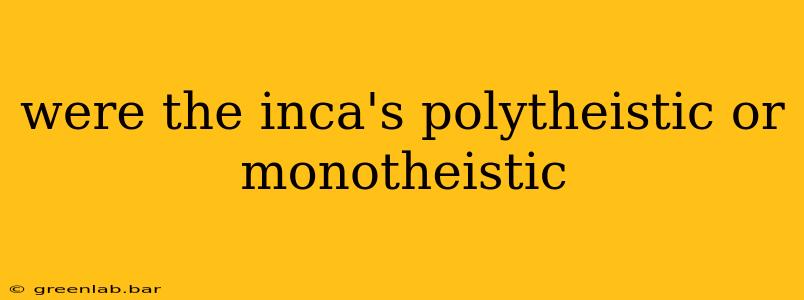The Inca religion is often described as polytheistic, given the vast pantheon of deities worshipped. However, a closer examination reveals a more nuanced picture, one that suggests a complex system with elements that could be interpreted as both polytheistic and, in a sense, monotheistic. Understanding this requires delving into the intricacies of their cosmology and religious practices.
The Inca Pantheon: A Multitude of Gods and Spirits
The Inca worshipped a vast array of gods and spirits, each with specific domains and responsibilities. Viracocha, the creator god, often occupies the top position, but his role and prominence varied across different Inca regions and throughout time. Other important deities included Inti (the sun god), Mama Killa (the moon goddess), and Pachamama (Mother Earth). These deities weren't simply abstract concepts; they were deeply intertwined with the Inca worldview, influencing everything from agriculture and weather patterns to social structures and political power. Numerous lesser deities and spirits also played crucial roles, reflecting the diverse landscapes and beliefs of the vast Inca Empire.
Beyond the Gods: Huacas and the Spiritual World
The Inca belief system extended far beyond the main deities. Huacas represented sacred objects, places, or beings that possessed spiritual power. These could include mountains, rocks, springs, even ancestors or deceased rulers. The veneration of Huacas demonstrates the pervasive nature of the spiritual world in Inca life, highlighting a connection between the physical and supernatural realms. This emphasis on local, specific deities and spirits further supports the argument for polytheism.
The Creator God Viracocha: A Monotheistic Tendency?
While the Inca pantheon was undeniably vast, the role of Viracocha is crucial in understanding the complexities of their religious beliefs. Viracocha was considered the creator of the universe, the source of all life, and the ultimate authority. Some scholars argue that Viracocha's position suggests a monotheistic or henotheistic tendency within Inca religion, where Viracocha is considered supreme even while other deities maintain significant importance.
This interpretation rests on several observations:
- Viracocha's Creation Myth: The stories surrounding Viracocha's creation of the world often place him above and beyond other gods, suggesting a hierarchical structure with him at the apex.
- Royal Connections: The Inca emperors often claimed descent from Viracocha, linking the divine creator to their legitimacy and authority. This elevation of Viracocha reinforced his status and potentially obscured the importance of other deities in official religious narratives.
- Syncretism and Adaptation: As the Inca Empire expanded, they incorporated the deities and beliefs of conquered peoples into their existing religious framework. This led to a complex synthesis of religious practices, making it difficult to define Inca religion with absolute clarity.
Conclusion: A Spectrum of Belief
Ultimately, labeling the Inca religion as strictly polytheistic or monotheistic is an oversimplification. Their belief system was complex and multifaceted, encompassing a broad pantheon of gods, spirits, and Huacas, yet also exhibiting a hierarchical structure with Viracocha often at the apex. Perhaps a more accurate description would be to acknowledge the spectrum of belief within Inca religion, recognizing both the polytheistic nature of their worship and the potential for a monotheistic or henotheistic interpretation centered around Viracocha. Further research and a careful examination of diverse sources are necessary to fully comprehend the richness and complexity of this fascinating ancient civilization's religious practices.

